Discover the power of SWOT analysis in optimizing your restaurant or food business. This comprehensive guide is designed to equip restaurant owners and food business entrepreneurs with the knowledge and tools to effectively conduct SWOT analysis for food business. From unraveling the core principles of SWOT analysis to providing detailed insights through real-world examples, this resource aims to empower you in making informed decisions that can elevate your business to new heights of excellence.
By the end, you'll have a robust foundation to assess, strategize, and position your business for long-term prosperity. Keep reading.
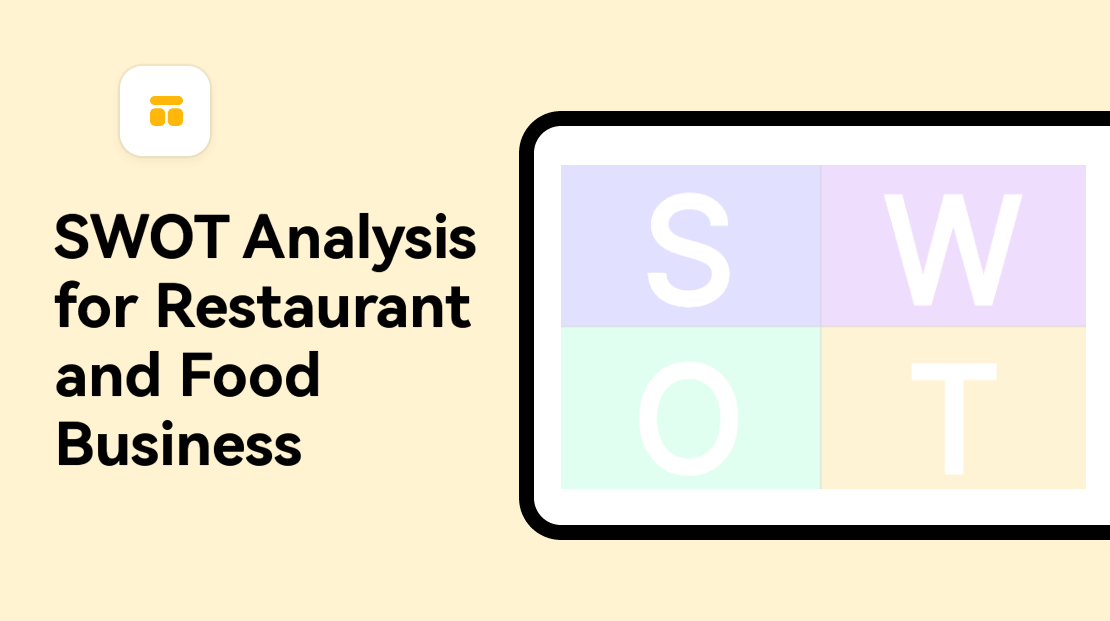
What Is the SWOT Analysis for Restaurant
The SWOT analysis for restaurant is a structured assessment that systematically evaluates internal strengths and weaknesses, as well as external opportunities and threats. This strategic tool provides a comprehensive overview of the restaurant's current position in the market and helps in devising effective strategies for growth and sustainability.

Restaurant Strengths
Restaurants provide jobs, create unique dining experiences, foster guest loyalty, and have a strong local presence. They offer menu items that are challenging to replicate at home and benefit from cost-effective ingredient sourcing.
Restaurant Weaknesses
Intense competition demands substantial marketing budgets. New openings can lead to staff turnover and increased rivalry. Similar cuisine offerings may lead to customer confusion. Establishing a solid brand presence can be challenging, and some struggle with online visibility and delivery logistics.
Restaurant Opportunities
Restaurants can enhance relevance through effective social media presence, positive reviews, local branding, special promotions, and expanding locations. Embracing online deliveries provides a convenient option for customers.
Restaurant Threats
Uniform offerings, economic challenges, reduced consumer spending, and supplier disruptions pose potential threats to restaurants' success and profitability.
[Detailed] SWOT Analysis of Food Business
Conducting a SWOT analysis for food business is pivotal in navigating the competitive landscape of the culinary industry. This comprehensive assessment encompasses internal strengths and weaknesses, as well as external opportunities and threats specific to food-related enterprises.

Internal Strengths
- Culinary Expertise and Menu Diversity: The food business excels in culinary skills and offers a diverse menu. This sets it apart in a competitive market, attracting patrons seeking unique dining experiences.
- Emphasis on Quality Ingredients: A strong commitment to sourcing and using high-quality ingredients is a foundational strength. This not only enhances the flavor and appeal of dishes but also contributes to the business's reputation for excellence.
Internal Weaknesses
- Operational Challenges: There may be specific operational challenges, such as inventory management or staff training needs, that impact the consistency and quality of offerings. Addressing these issues is essential for sustained success.
- Customer Service Gaps: Recognizing and rectifying any customer service gaps is crucial. This ensures that every interaction with patrons is positive, fostering satisfaction and building customer loyalty.
External Opportunities
- Consumer Dietary Trends: Staying attuned to evolving consumer preferences and dietary trends provides opportunities for menu innovation. Offering options that cater to specific dietary needs or preferences can broaden the customer base.
- Strategic Partnerships and Collaborations: Establishing partnerships with local suppliers or collaborating with complementary businesses can expand the business's reach and enhance visibility. These alliances can lead to mutually beneficial ventures.
External Threats
- Intense Industry Competition: The food industry is highly competitive, demanding continuous innovation and adaptation to stand out. Staying ahead of competitors requires vigilance and a commitment to providing unique value.
- Fluctuating Food Costs and Supply Chain Disruptions: Economic factors and supply chain disruptions can impact profitability. Effective financial planning and adaptability are crucial in navigating these challenges.
SWOT Analysis for Restaurant Examples
In this section, we'll delve into specific SWOT analysis examples, providing a clear understanding of the unique dynamics within each category:
SWOT Analysis of a Restaurant Example - Fine Dining

Strengths
The establishment boasts a stellar reputation, drawing discerning patrons seeking sophistication and culinary artistry. Additionally, the restaurant prides itself on impeccable service, ensuring a seamless dining affair.
Weaknesses
However, fine dining establishments often face challenges related to high operating costs. The extensive use of premium ingredients and the demand for a refined ambiance can lead to higher expenses.
Opportunities
Fine dining restaurants have the opportunity to tap into the rising trend of experiential dining. Offering curated tasting menus or unique themed events can enhance customer engagement and attract a loyal clientele.
Threats
In this competitive landscape, staying at the pinnacle of fine dining requires constant innovation. The risk of economic downturns affecting discretionary spending and consumer preferences shifting towards more casual dining experiences are potential threats.
SWOT Analysis of a Restaurant Example - Casual Dining
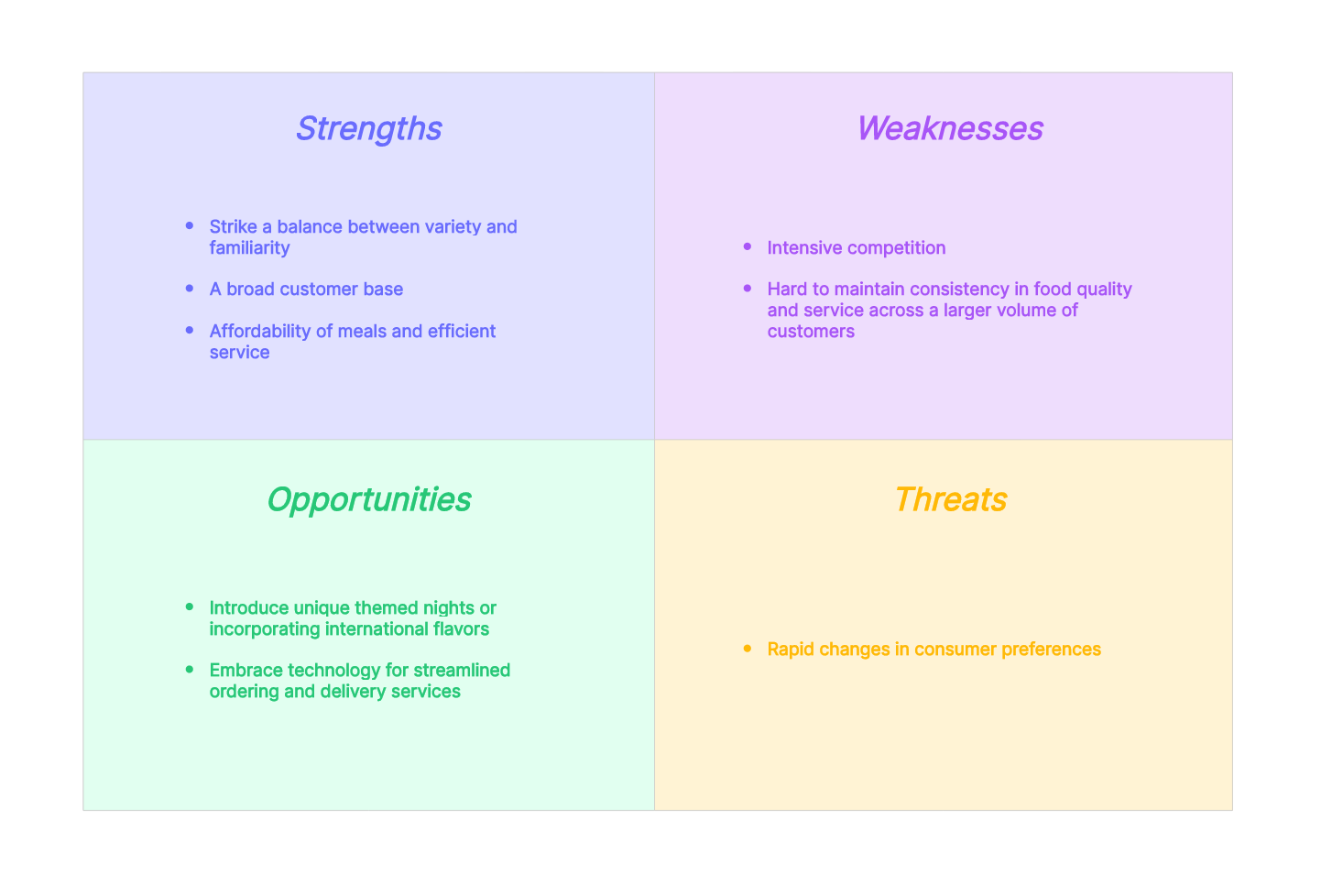
Strengths
This casual dining establishment thrives on providing a relaxed, family-friendly atmosphere. Its menu strikes a balance between variety and familiarity, appealing to a broad customer base. The affordability of meals and efficient service contribute to a loyal customer following.
Weaknesses
Casual dining restaurants may face challenges in differentiating themselves from competitors in a crowded market. Maintaining consistency in food quality and service across a larger volume of customers can be a significant hurdle.
Opportunities
There is room for innovation in the casual dining space. Introducing unique themed nights or incorporating international flavors can attract a diverse clientele. Embracing technology for streamlined ordering and delivery services can enhance convenience and appeal to a wider audience.
Threats
In the casual dining segment, rapid changes in consumer preferences can be a significant threat. Adapting to dietary trends and providing healthier options may become increasingly important.
SWOT Analysis of a Restaurant Example - Fast Food
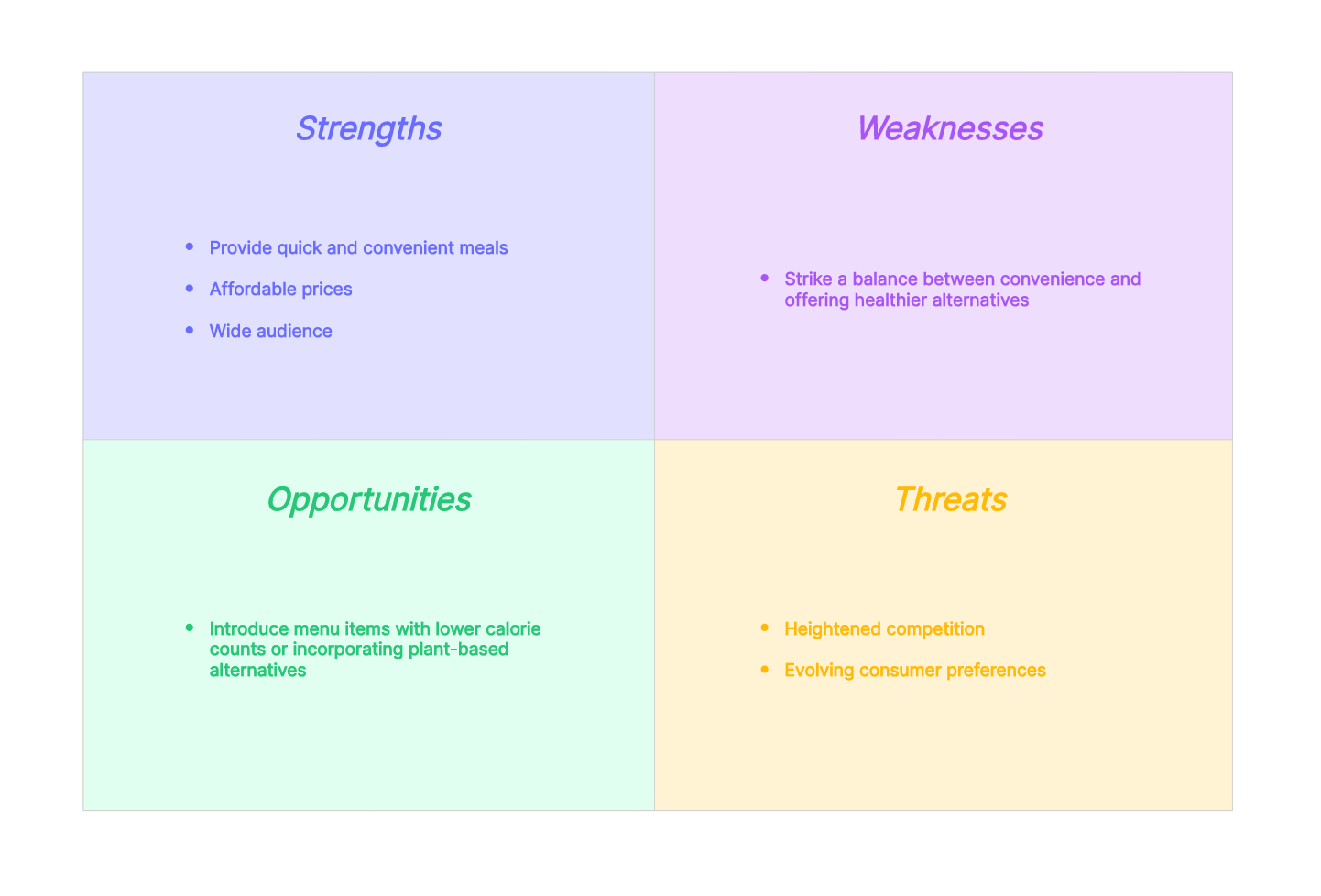
Strengths
This fast-food restaurant excels in providing quick and convenient meals at affordable prices. The menu is designed for efficiency, featuring familiar options that cater to a wide audience.
Weaknesses
Fast food establishments may grapple with perceptions related to health and nutrition. Striking a balance between convenience and offering healthier alternatives can be a challenge.
Opportunities
Fast food restaurants have the opportunity to capitalize on the growing demand for healthier and customizable options. Introducing menu items with lower calorie counts or incorporating plant-based alternatives can broaden the customer base.
Threats
In the fast-food sector, heightened competition and evolving consumer preferences pose significant threats. Staying attuned to changing tastes and trends is crucial for remaining relevant.
SWOT Analysis of a Restaurant Example - Café or Bistro
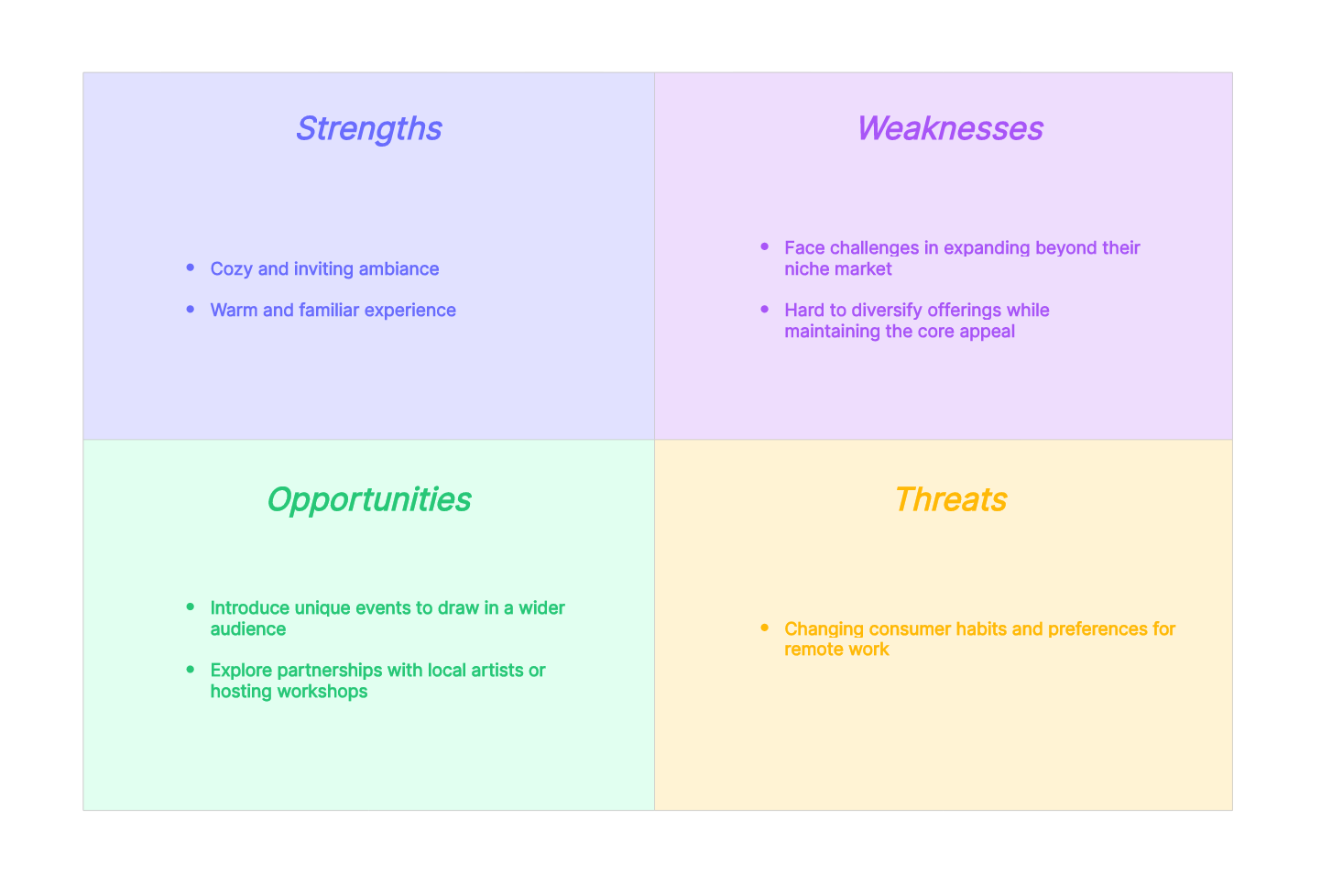
Strengths
This café or bistro thrives on offering a cozy and inviting ambiance, making it a popular spot for casual gatherings and work meetings. The menu emphasizes quality coffee and freshly baked goods, providing a warm and familiar experience.
Weaknesses
Cafés and bistros may face challenges in expanding beyond their niche market. Diversifying offerings while maintaining the core appeal can be a delicate balancing act.
Opportunities
There is room for innovation in the café and bistro space. Introducing unique events such as live music nights or art exhibitions can draw in a wider audience. Exploring partnerships with local artists or hosting workshops can enhance the community-oriented experience.
Threats
In this segment, changing consumer habits and preferences for remote work may impact foot traffic. Adapting to evolving needs, such as providing robust Wi-Fi and comfortable workspaces, may become increasingly important.
SWOT Analysis of a Restaurant Example - Buffet

Strengths
This buffet-style restaurant distinguishes itself by offering a wide array of options, catering to diverse tastes and preferences. The all-you-can-eat format provides excellent value for patrons seeking variety. Efficient self-service operations and lower labor costs contribute to profitability.
Weaknesses
Buffet restaurants face challenges in maintaining food quality and minimizing waste due to the self-service nature of the model. Ensuring a fresh and appealing presentation throughout service hours requires careful planning.
Opportunities
Buffet-style restaurants have the opportunity to capitalize on special events and occasions. Offering themed nights or promotions can attract larger groups and increase revenue.
Threats
In the buffet segment, evolving health and safety standards, particularly in light of global events, require strict adherence. Implementing stringent sanitation measures and reimagining service layouts may be essential.
SWOT Analysis Template & Tool
A SWOT analysis template is an invaluable resource for businesses aiming to evaluate their internal strengths and weaknesses alongside external opportunities and threats. Among the array of tools available, Boardmix stands out as an exceptionally efficient platform.

Boardmix streamlines the SWOT analysis process, offering a user-friendly interface that facilitates comprehensive assessments. It provides pre-defined templates and intuitive features that enable teams to collaborate seamlessly in real-time. What sets Boardmix apart is its dynamic functionality, allowing for easy customization and integration of data. This tool also offers visualization options that enhance clarity and insights.
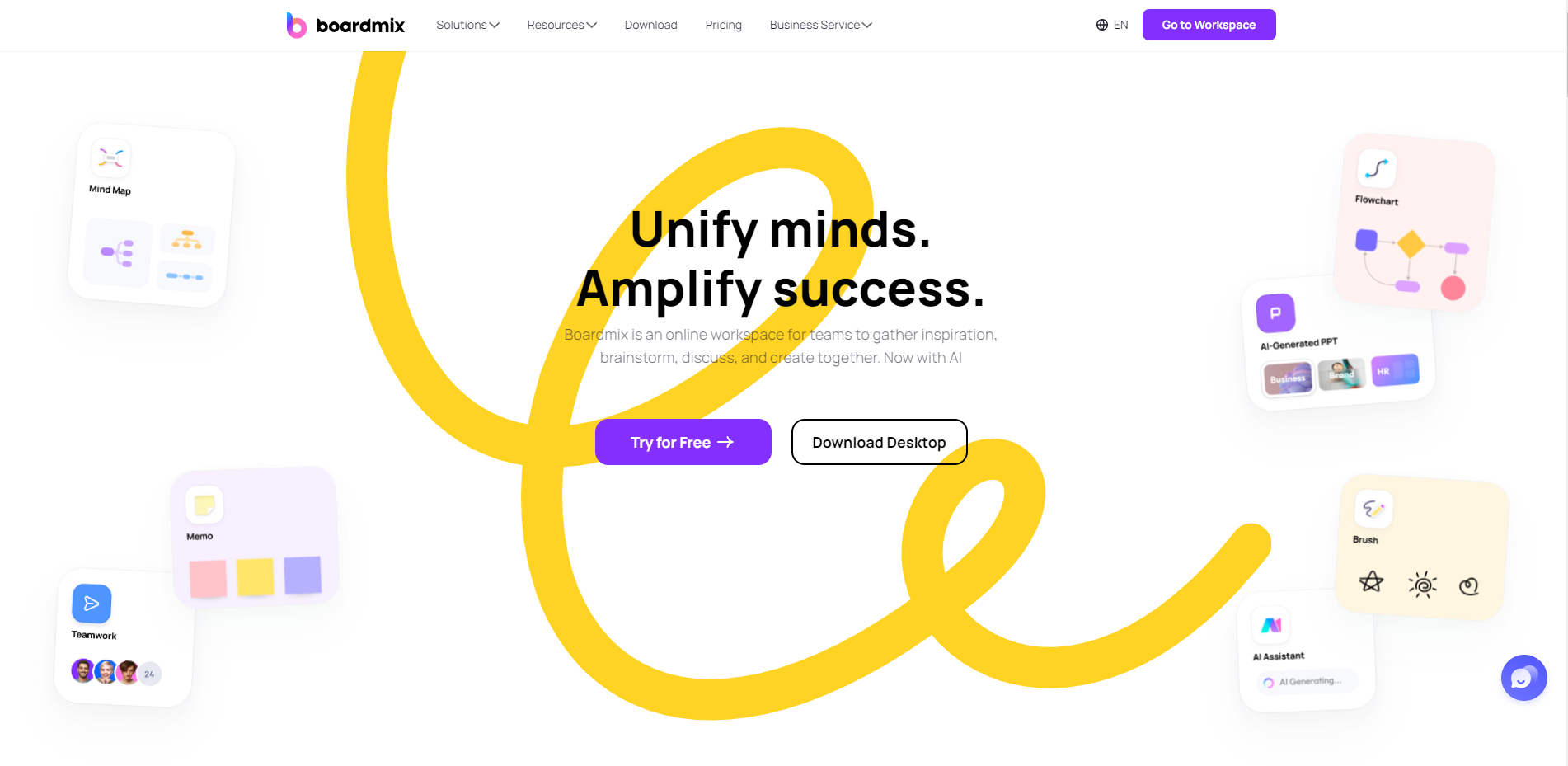
Moreover, Boardmix surpasses conventional methods by offering advanced analytical capabilities. This level of automation and intelligence significantly expedites the decision-making process.
Conclusion
Conducting a SWOT analysis for restaurant and swot analysis for food business is a strategic imperative. This assessment, coupled with tools like Boardmix, streamlines the process, allowing for efficient collaboration and advanced analytical insights. By leveraging these insights, businesses can navigate the dynamic culinary landscape, capitalizing on their strengths and opportunities, while effectively addressing weaknesses and mitigating potential threats for sustained success.









